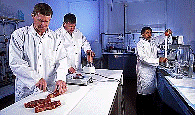United States Department of Agriculture: Agricultural Research Service, Lincoln, Nebraska

Roman L. Hruska U.S. Meat Animal Research Center: Reports
Date of this Version
2002
Document Type
Article
Citation
Published in Small Ruminant Research 43 (2002) 65–74.
Abstract
Reproductive traits from 7642 ewes were recorded from 1975 to 1983. The ewes were of five breeds (Dorset (D), Finnsheep (F), Rambouillet (R), Suffolk (S) and Targhee (T)) and two composite lines [C1 (1/2F + 1/4R + 1/4D) and C2 (1/2F + 1/4S + 1/4T)]. Genetic parameters were estimated for six basic and seven composite traits. The basic traits were conception rate (CR), total number of lamb born (NLB), number of lambs born alive (NLBA), number of lambs alive at weaning (NLAW), litter mean weight per lamb born (LMWLB) and litter mean weight per lamb weaned (LMWLW). The composite traits were ratio of lambs surviving to weaning relative to NLB (LSW = NLAW/NLB), number of lambs born per ewe exposed (NLBEE = CR × NLB), number of lambs weaned per ewe exposed (NLWEE = CR × NLAW), total litter weight at birth (TLWB = NLB × LMWLB), total litter weight at weaning (TLWW = NLAW × LMWLW), total litter weight at birth per ewe exposed (TLWBEE = CR × NLB × LMWLB) and total litter weight at weaning per ewe exposed (TLWWEE = CR × NLAW × LMWLW). Year, age of ewe, breed of ewe, hormone treatment and season of breeding were used as fixed effects. Direct and maternal genetic effects, permanent environmental effects of ewe and mate of ewe were considered to be random effects. A derivative-free algorithm was used to obtain REML estimates of genetic and environmental parameters. Estimates of heritabilities for animal genetic and permanent environmental and maternal genetic effects were mainly small due to the typical high influence of environmental factors on reproductive traits and to non-normal distributions of traits. Mate of ewe effects were not important for any trait. Important genetic correlations were found between some traits. Some estimates of genetic correlations do not seem to have a biological explanation. Nevertheless, these estimates of genetic correlations among traits may provide a basis for deriving selection indexes for reproductive traits.

